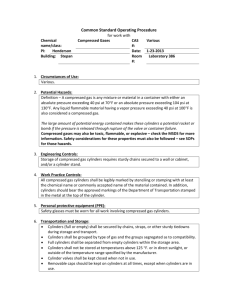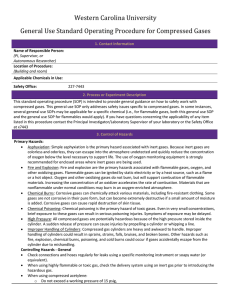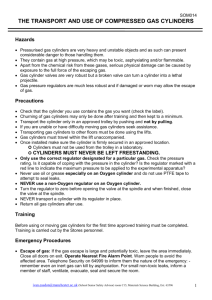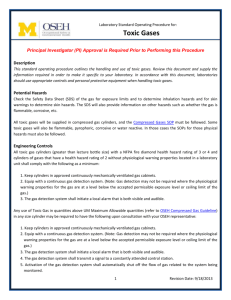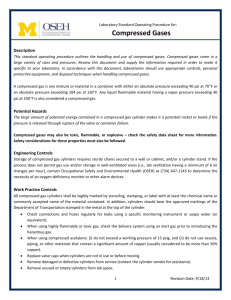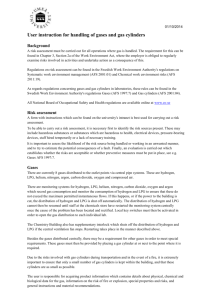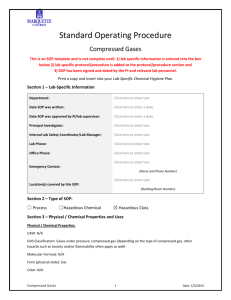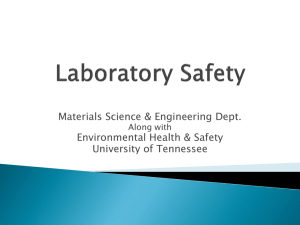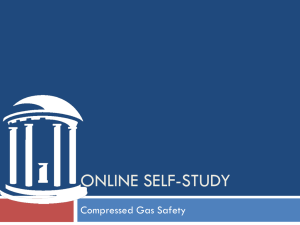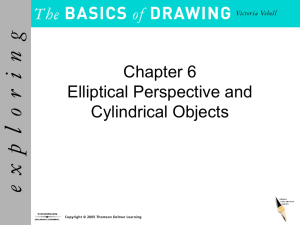Template
advertisement
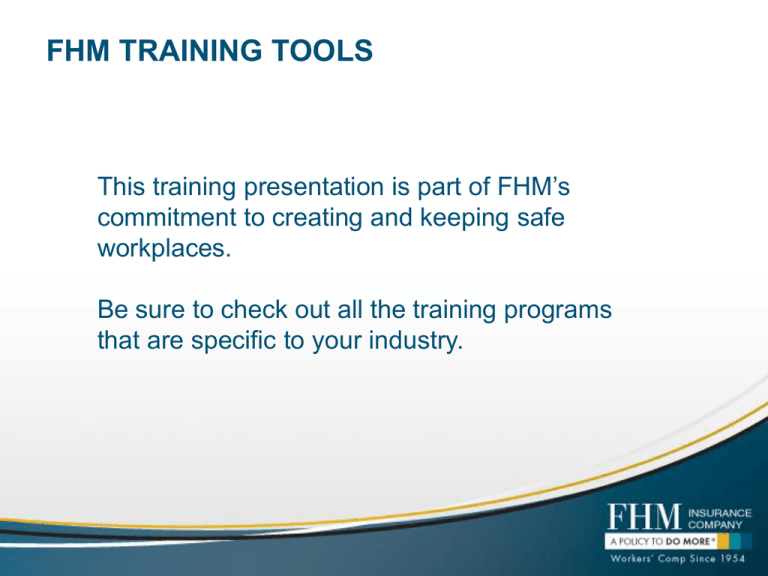
FHM TRAINING TOOLS This training presentation is part of FHM’s commitment to creating and keeping safe ►►► workplaces. Be sure to check out all the training programs that are specific to your industry. These materials have been developed based on applicable federal laws and regulations in place at the time the materials were created. The program is being provided for educational and informational purposes only and does not constitute and is not intended to provide OSHA compliance certification, regulatory compliance, a substitute for any "hands on“ training required by applicable laws and regulations, or other legal or professional advice or services. By accessing the materials, you assume all responsibility and risk arising from the use of the content contained therein. ©2010 Grainger Safety Services, Inc. Compressed Gases ►►► These materials have been developed based on applicable federal laws and regulations in place at the time the materials were created. The program is being provided for educational and informational purposes only and does not constitute and is not intended to provide OSHA compliance certification, regulatory compliance, a substitute for any "hands on“ training required by applicable laws and regulations, or other legal or professional advice or services. By accessing the materials, you assume all responsibility and risk arising from the use of the content contained therein. ©2010 Grainger Safety Services, Inc. Learning Objectives At the conclusion of this presentation, you will: ► Know types of gases in compressed gas cylinders ► Recognize ► Know hazards associated with these gases safe use practices of compressed gases Agenda Presentation agenda: ► Information ► Chemical ► Your on compressed gases and cylinders and physical hazards responsibilities ►Section 1 Compressed Gases and Cylinders Information Compressed Gas Cylinders Standard portable industrial gas cylinder: ► Stores ► 57in gases at high pressures tall, 9in diameter ► One-quarter ► About ► 330 inch thickness 155lbs in weight when filled cubic ft of gas at 2640 lbs per square inch Four Types of Compressed Gases Substance types in gas cylinders: ► Gas at standard temperature, increased pressure ► Liquefies at standard temperature, increased pressure ► Dissolved ► Liquefies in a solvent at reduced temperature, increased pressure Gas at STP Gases at standard temperature: ► Air ► Argon ► Helium ► Nitrogen ► Oxygen Liquefied Gases Liquefied gases at standard temperature: ► Butane ► Propane ► Carbon dioxide ► Nitrous oxide Dissolved Gases Gases dissolved in a solvent at standard temperature: ► Acetylene Cryogenic Gases Liquefied gases at reduced temperature: ► Liquid nitrogen ► Liquid oxygen ► Carbon dioxide Hazards of Compressed Gas Systems Hazards of use, storage, and handling of cylinders: ► Chemical hazards: –Associated with cylinder contents ► Physical hazards: –Due to presence of a high pressure vessel ►Section 2 Chemical Hazards Chemical Hazards Chemical hazards of compressed gases: ► Flammable ► Corrosive ► Explosive ► Poisonous ► Inert ► Acidic ► Reactive Labeling and Material Safety Data Sheets Labeling and MSDS practices: ► Cylinders may be stenciled or stamped ► Three-part tag systems ► Cylinder color-coding is unreliable ► Periodic inspections ► All gases to be included in: – Hazard communication chemical inventory – Material Safety Data Sheets Segregation Compressed gases should be segregated from: ► High traffic areas ► Oil and grease ► Flames, sparks, heat, or ignition ► Electrical circuits Cylinders should be protected from: ► Ground ► Direct sunlight ► Dampness ► Salt and other corrosives Fire Protection Cylinders containing flammable gases should be: ► Separated from cylinders containing oxidizing gas: – 20 feet – 5 foot fire-resistant barrier ► Stored ► Use in a well-ventilated space flow restrictors or surge protectors Cylinder Leaks Leak detection procedures: ► For flammable gas – soapy water solution ► Temperatures at or below freezing use 50% glycerin-water ► For toxic/corrosive gas – test with inert gas ► Establish emergency procedures Engineering Controls Common engineering controls: ► Emergency ► Gas ► Flow shutoff switch cylinder cabinets restrictors ► Emergency eyewash ►Section 3 Physical Hazards Physical Hazards Container may rupture due to: ► Forklift puncture ► Knocked over Ruptured tanks ► May become projectiles ► Release ► Turn toxic gas into the atmosphere the environment flammable Securing Cylinders Gas cylinders must be secured at all times: ► In a vertical position ► Secured at 2/3 of it’s height with: – Chain, plastic coated wire cable, or straps ► Secured individually Transporting Cylinders Rules for transporting: ► Never drag, slide, or roll a cylinder ► Always ► Never have valve cap on transport with regulator in place ► Ensure it’s secured to cart ► Do not drop or strike against objects ► Do not lift by valve cover ► Do not use ropes or slings Cylinder Testing Test information marked on cylinder: ► Hydrostatic and burst testing are most common ► Hydrostatic or ultrasonic testing is required every 5 - 10 years 1. 2. 3. 4. 5. 6. 7. 8. DOT Specifications – Material or Construction Serial Number Registered Owner Date of Manufacture and original hydrostatic test Neck Ring – Current Owner Retest Markings Barcode Cylinder Manufacturers Marking TW = Tare Weight Valve Connections Cylinder attachments: ► Cap over valve to protect it ► Some cylinders have a protective frame ► Pressure regulator: – Pressure gauge – Flow adjustment Gas Lines and Piping Guidelines: ► All gas lines should be labeled ► Hoses should be examined ► Avoid unnecessarily long hoses ► Keep hoses free of kinks ► Keep hoses away from high traffic areas ► Repair ► One leaks promptly hose per type of gas The Regulator Precautions: ► Make sure correct regulator is equipped ► Inspect regulator and cylinder ► Never use grease or oil ► Valve handle should be easily accessible ► Use proper tools for valves ► Check ► Fire MSDS extinguishers ► Valve outlet facing away Cylinder Storage Storage area should be: ► Away from heat and ignition sources ► Designated ► Marked “no smoking” as gas storage ► Restricted ► Provided access with appropriate equipment Cylinder Storage (continued) Gas containers should be: ► Capped, stood upright, and properly secured ► Segregated according to categories ► Segregated according to full or empty ► Manage so oldest is used first ► Periodically checked for condition Empty Cylinders Proper procedure: ► Considered ► Labeled full until identified as empty by user “M T” or tagged when empty ► Empty cylinders are returned to supplier ► Leave 25 psig minimum pressure ► Do not leave empty cylinders attached to pressurized system ►Section 4 Your Responsibilities Your Responsibilities Your responsibilities include: ► Knowing content of cylinders used ► Regulator, ► Following ► Knowing valve, and hose maintenance rules for storage, transportation, and use what to do in an emergency Additional Information Compressed Gas Safety: General Safety Guidelines, Montana Department of Labor and Industry Air Products Safety Grams http://www.airproducts.com/index.asp Compressed Gas Association (CGA) www.cganet.com Compressed Gases Self Inspection Checklist, National Institute for Occupational Safety and Health (NIOSH) Safety Checklist Program for Schools
